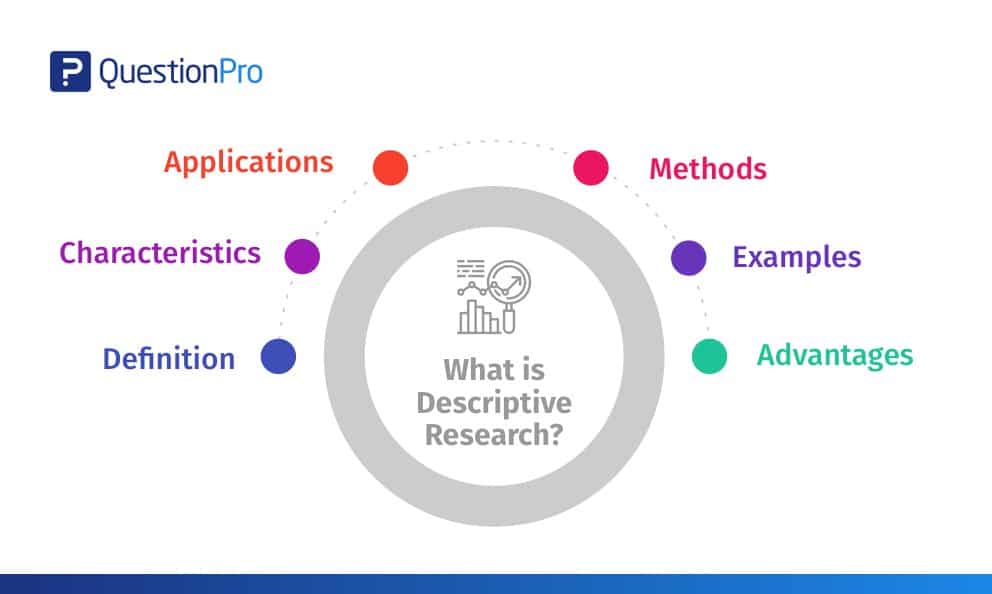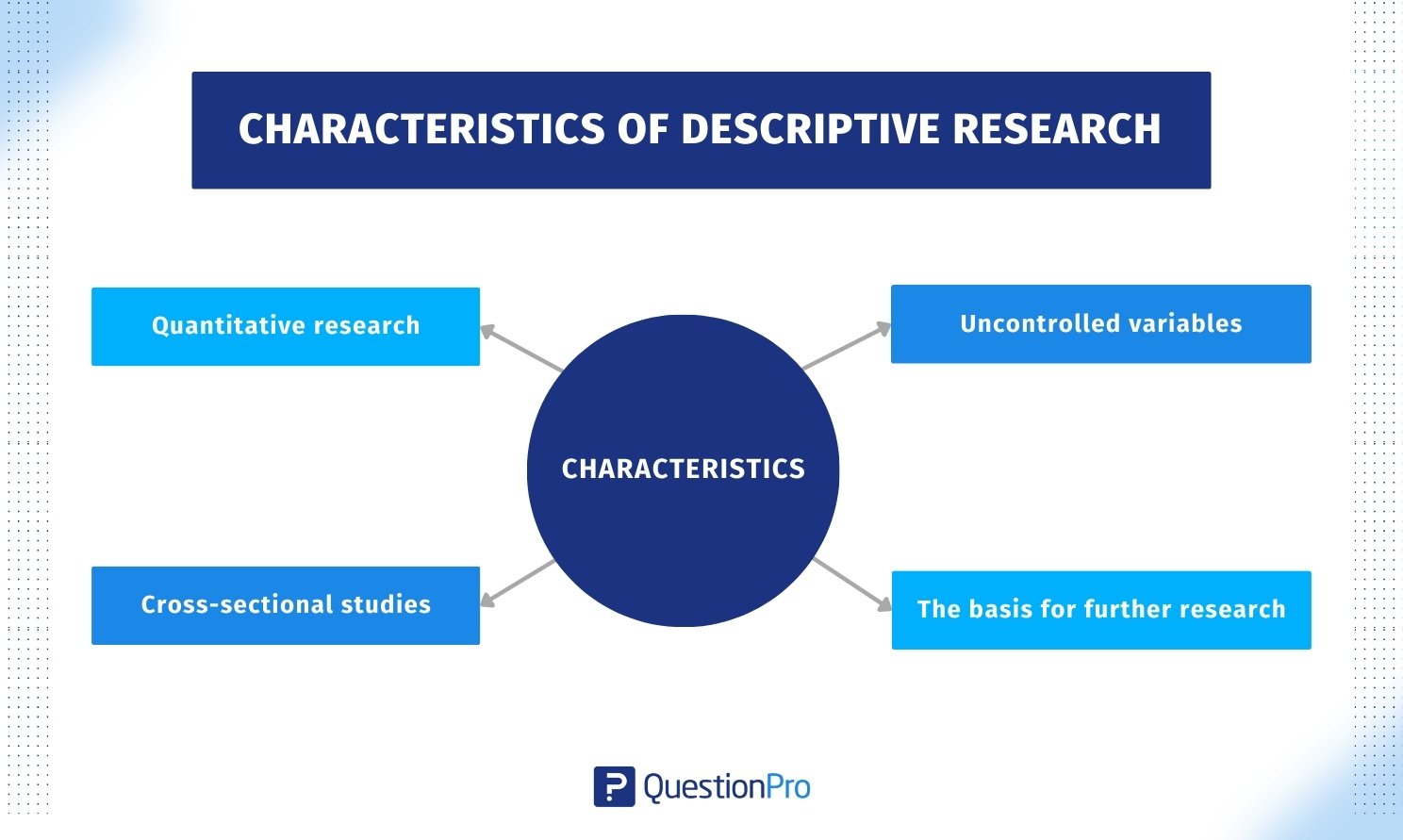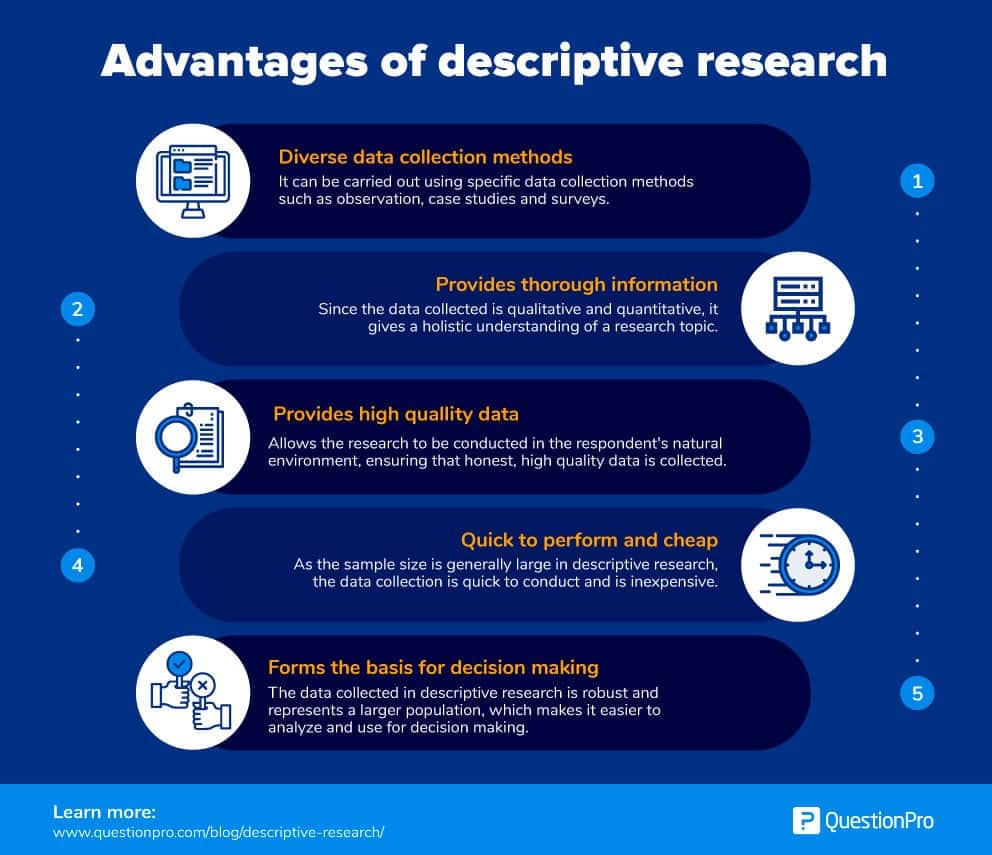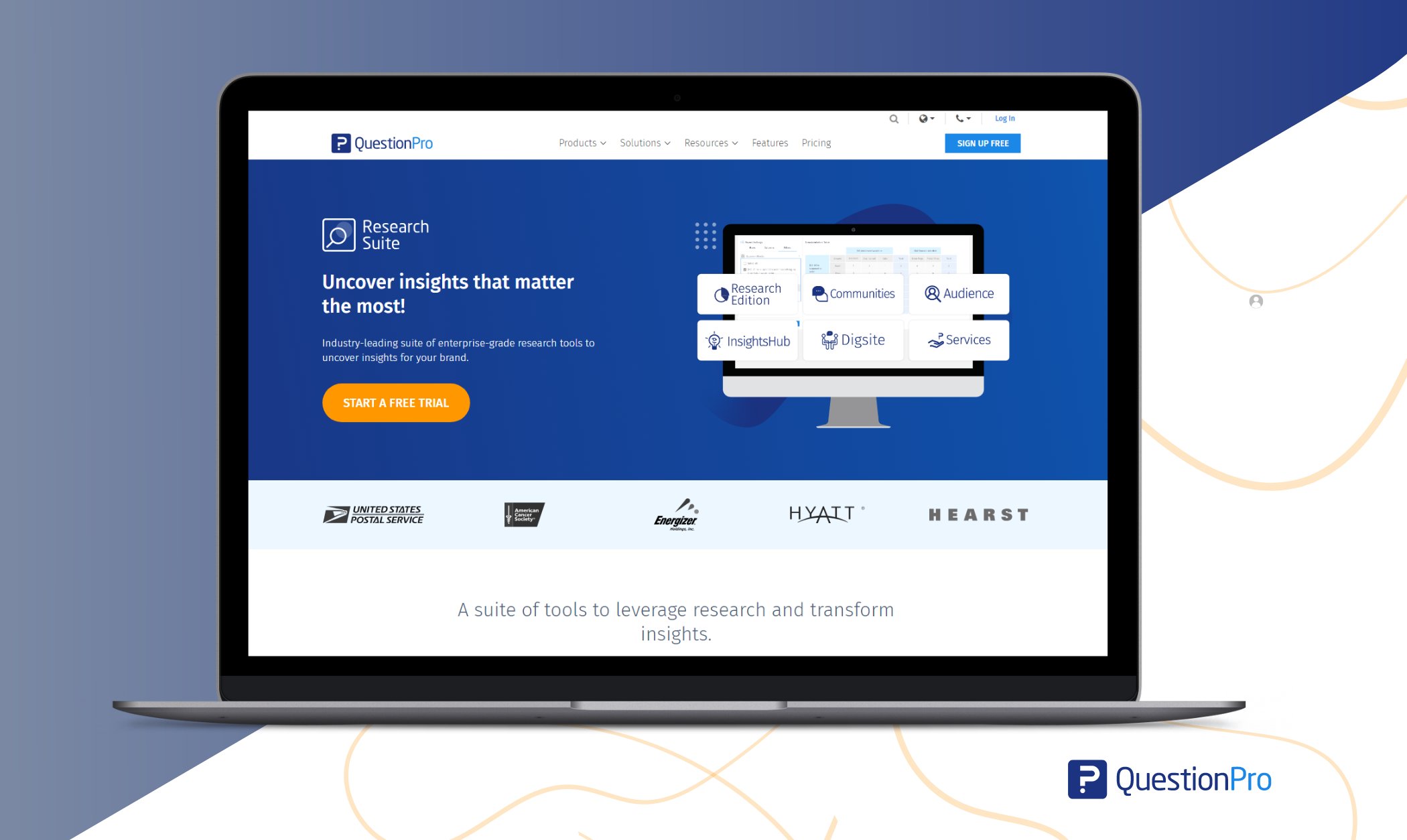
Suppose an apparel brand wants to understand the fashion purchasing trends among New York’s buyers, then it must conduct a demographic survey of the specific region, gather population data, and then conduct descriptive research on this demographic segment.
The study will then uncover details on “what is the purchasing pattern of New York buyers,” but will not cover any investigative information about “why” the patterns exist. Understanding the nature of the market is the study’s main goal for the apparel brand trying to break into this market.
This type of research offers extensive advantages and applications, making it a potential game-changer for those who incorporate it into their business toolkit. Want to learn more? Keep reading to uncover everything you need to know to master and make the most of this valuable approach.
What is Descriptive Research?
Descriptive research is a method describing the characteristics of the population or phenomenon studied. This descriptive methodology focuses more on the “what” of the research subject than the “why” of the research subject.
The method primarily focuses on describing the nature of a demographic segment without focusing on “why” a particular phenomenon occurs. In other words, it “describes” the research subject without covering “why” it happens.
Descriptive Design
A widely used concept in this type of research is descriptive design. This methodology combines quantitative and qualitative approaches to gather information that allows for the description of specific cases under study. Popular methods include case studies, surveys, and observations, which we will explore later.
One of the main advantages of using this data type is that it enables manipulation through disciplines like statistics to predict and gain an in-depth understanding of specific phenomena.
Characteristics of Descriptive Research
The term descriptive research then refers to research questions, the design of the study, and data analysis conducted on that topic. We call it an observational research method because none of the research study variables are influenced in any capacity.
Some characteristics of descriptive research are:

- Quantitative research: It is a quantitative research method that attempts to collect quantifiable information for statistical analysis of the population sample. It is a popular market research tool that allows us to collect and describe the demographic segment’s nature.
- Uncontrolled variables: In it, none of the variables are influenced in any way. This uses observational methods to conduct the research. Hence, the nature of the variables or their behavior is not in the hands of the researcher.
- Cross-sectional studies: It is generally a cross-sectional study where different sections belonging to the same group are studied.
- The basis for further research: Researchers further research the data collected and analyzed from descriptive research using different research techniques. The data can also help point towards the types of research methods used for the subsequent research.
Applications of Descriptive Research With Examples
A descriptive research method can be used in multiple ways and for various reasons. Before getting into any survey, though, the survey goals and survey design are crucial. Despite following these steps, there is no way to know if one will meet the research outcome. How to use descriptive research? To understand the end objective of research goals, below are some ways organizations currently use descriptive research today:
1. Define Respondent Characteristics
The aim of using close-ended questions is to draw concrete conclusions about the respondents. This could be the need to derive patterns, traits, and behaviors of the respondents. It could also be to understand from a respondent their attitude, or opinion about the phenomenon. For example, understand millennials and the hours per week they spend browsing the internet. All this information helps the organization researching to make informed business decisions.
2. Measure Data Trends
Researchers measure data trends over time with a descriptive research design’s statistical capabilities. Consider if an apparel company researches different demographics like age groups from 24-35 and 36-45 on a new range launch of autumn wear. If one of those groups doesn’t take too well to the new launch, it provides insight into what clothes are like and what is not. The brand drops the clothes and apparel that customers don’t like.
3. Conduct Comparisons
Organizations also use a descriptive research design to understand how different groups respond to a specific product or service. For example, an apparel brand creates a survey asking general questions that measure the brand’s image. The same study also asks demographic questions like age, income, gender, geographical location, geographic segmentation, etc. This consumer research helps the organization understand what aspects of the brand appeal to the population and what aspects do not. It also helps make product or marketing fixes or even create a new product line to cater to high-growth potential groups.
4. Validate Existing Conditions
Researchers widely use descriptive research to help ascertain the research object’s prevailing conditions and underlying patterns. Due to the non-invasive research method and the use of quantitative observation and some aspects of qualitative observation, researchers observe each variable and conduct an in-depth analysis. Researchers also use it to validate any existing conditions that may be prevalent in a population.
5. Conduct Research at Different Times
The analysis can be conducted at different periods to ascertain any similarities or differences. This also allows any number of variables to be evaluated. For verification, studies on prevailing conditions can also be repeated to draw trends.
Advantages of Descriptive Research
Some of the significant advantages of descriptive research are:

- Data collection: A researcher can conduct descriptive research using specific methods like observational method, case study method, and survey method. Between these three, all primary data collection methods are covered, which provides a lot of information. This can be used for future research or even for developing a hypothesis for your research object.
- Varied: Since the data collected is qualitative and quantitative, it gives a holistic understanding of a research topic. The information is varied, diverse, and thorough.
- Natural environment: Descriptive research allows for the research to be conducted in the respondent’s natural environment, which ensures that high-quality and honest data is collected.
- Quick to perform and cheap: As the sample size is generally large in descriptive research, the data collection is quick to conduct and is inexpensive.
Descriptive Research Methods
There are three distinctive methods to conduct descriptive research. They are:
01. Observational Method
The observational method is the most effective method to conduct this research, and researchers make use of both quantitative and qualitative observations.
A quantitative observation is the objective collection of data primarily focused on numbers and values. It suggests “associated with, of or depicted in terms of a quantity.” Results of quantitative observation are derived using statistical and numerical analysis methods. It implies observation of any entity associated with a numeric value such as age, shape, weight, volume, scale, etc. For example, the researcher can track if current customers will refer the brand using a simple Net Promoter Score question.
Qualitative observation doesn’t involve measurements or numbers but instead just monitoring characteristics. In this case, the researcher observes the respondents from a distance. Since the respondents are in a comfortable environment, the characteristics observed are natural and effective.
In a descriptive research design, the researcher can choose to be either a complete observer, an observer as a participant, a participant as an observer, or a full participant. For example, in a supermarket, a researcher can from afar monitor and track the customers’ selection and purchasing trends. This offers a more in-depth insight into the purchasing experience of the customer.
02. Case Study Method
Case studies involve in-depth research and study of individuals or groups. Those studies lead to a hypothesis and widen a further scope of studying a phenomenon. However, case studies should not be used to determine cause and effect as they can’t make accurate predictions because there could be a bias on the researcher’s part.
The other reason why case studies are not a reliable way of conducting descriptive research is that there could be an atypical respondent in the survey. Describing them leads to weak generalizations and moving away from external validity.
03. Survey Research
In survey research, respondents answer through surveys or questionnaires or polls. They are a popular market research tool to collect feedback from respondents. A study to gather useful data should have the right survey questions. It should be a balanced mix of open-ended questions and close ended-questions. The survey method can be conducted online or offline, making it the go-to option for descriptive research where the sample size is enormous.
Examples of Descriptive Research
Some examples of descriptive research are:
- A specialty food group launching a new range of barbecue rubs would like to understand what flavors of rubs are favored by different people. To understand the preferred flavor palette, they conduct this type of research study using various methods like observational methods in supermarkets. By also surveying while collecting in-depth demographic information, offers insights about the preference of different markets. This can also help tailor make the rubs and spreads to various preferred meats in that demographic. Conducting this type of research helps the organization tweak their business model and amplify marketing in core markets.
- Another example of where this research can be used is if a school district wishes to evaluate teachers’ attitudes about using technology in the classroom. By conducting surveys and observing their comfortableness using technology through observational methods, the researcher can gauge what they can help understand if a full-fledged implementation can face an issue. This also helps in understanding if the students are impacted in any way with this change.
Some other research problems and research questions that can lead to descriptive research are:
- Market researchers want to observe the habits of consumers.
- A company wants to evaluate the morale of its staff.
- A school district wants to understand if students will access online lessons rather than textbooks.
- To understand if its wellness questionnaire programs enhance the overall health of the employees.
Use QuestionPro Research Suite for Descriptive Research
QuestionPro Research Suite is a versatile tool suitable for supporting exploratory research (which seeks to generate new ideas) and incredibly descriptive research that strives to describe features of populations or a phenomenon.
You can use descriptive research with this method as follows:

01. Survey Design
- Survey Design: With QuestionPro, online surveys can be highly customized. You have access to many different survey templates. This is great for a quick but descriptive study that you need up and running in hours rather than days. If you are still familiar with how surveys should be set up, this space will provide some structure.
- Data Collection: Surveys can be disseminated in various ways, such as via email, social media/website pop-ups, QR codes, or mobile devices, to target a large and diverse audience.
- Real-Time Analytics: QuestionPro is equipped with a set of tools to analyze data and responses after the survey has started. Visualizing trends and patterns is extremely important in descriptive research.
- Advanced Reporting: Reports can be automatically made and described in detail about your research findings. This will make your descriptive research data results easier by creating reports that can incorporate graphs, charts, and summaries.
- Panel Integration: You may need a measurement over research samples. In this case, you can take advantage of the integrated QuestionPro respondent panel to provide a more diverse set of participants so that your data will reflect the person about whom it was collected.
Using QuestionPro’s Research Suite, you can efficiently design and conduct descriptive research, gaining valuable insights into your research questions with robust data collection and analysis tools.
Conclusion
Descriptive research is a powerful method for understanding and summarizing a population’s or phenomenon’s characteristics. It provides a clear snapshot of “what is” without manipulating variables, making it invaluable for gathering factual data, identifying patterns, and informing decision-making.
While it doesn’t establish cause-and-effect relationships, it serves as a foundational tool in research, helping researchers and organizations gain insights into trends, behaviors, and conditions within a specific context.
Using tools like QuestionPro Research Suite significantly boosts the effectiveness of descriptive research by offering customizable survey designs, real-time analytics, and powerful data collection features. With QuestionPro, researchers can seamlessly gather in-depth insights and analyze data efficiently, ensuring accurate and actionable results.
Frequently Asked Questions ( FAQs) about Descriptive Research
Descriptive research is a method for observing and describing the characteristics of a population or phenomenon without manipulating variables. It focuses on providing a clear snapshot of “what is,” helping researchers gather factual information, identify patterns, and inform decision-making.
For Example: A survey measuring the average age, income level, and shopping habits of customers at a local grocery store.
The goal of descriptive research is to systematically define and summarize the characteristics of a population or phenomenon, providing a clear understanding of “what is” without establishing cause-and-effect relationships. It aims to gather factual data, identify patterns, and inform decision-making.
Descriptive research can be both qualitative and quantitative. It aims to describe characteristics or phenomena and may use numerical data (quantitative) or detailed observations and descriptions (qualitative) depending on the study’s goals.







